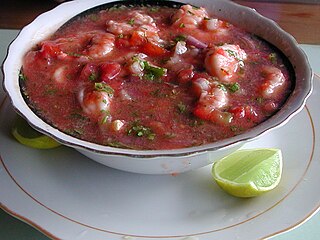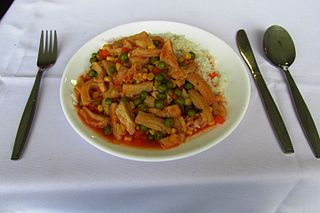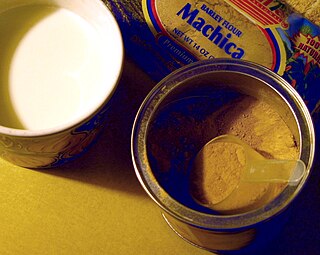 W
WEcuadorian cuisine is diverse, varying with altitude, and associated agricultural conditions. Beef, chicken, and seafood are popular in the coastal regions and are typically served with carbohydrate-rich foods, such as rice accompanied with lentils, pasta, or plantain, whereas in the mountainous regions pork, chicken, beef and cuy are popular and are often served with rice, corn, or potatoes. A popular street food in mountainous regions is hornado, consisting of potatoes served with roasted pig. Some examples of Ecuadorian cuisine in general include patacones, llapingachos, and seco de chivo. A wide variety of fresh fruit is available, particularly at lower altitudes, including granadilla, passionfruit, naranjilla, several types of banana, uvilla, taxo, and tree tomato.
 W
WThis is a list of Ecuadorian dishes and foods. Ecuadorian cuisine, the cuisine of Ecuador, is diverse, varying with altitude and associated agricultural conditions. On the coast, a variety of seafood, grilled steak and/or chicken are served along with fried plantain, rice and beans. Stewed beef and goat are traditional too. The most traditional seafood dishes are ceviche and fish soup. Also, there are a variety of soups based on local vegetables, like sopa de queso and caldo de bolas, a soup based on plantains. These are soup "alike" dishes cooked with lemon.
 W
WAjí is a spicy sauce that often contains tomatoes, cilantro (coriander), ají pepper, onions, and water.
 W
WAn alfajor or alajú is a traditional confection found in Argentina, Bolivia, Chile, Colombia, Ecuador, Paraguay, Peru, the Philippines, Southern Brazil, Southern France, Spain, Uruguay, and Venezuela. The archetypal alfajor entered Iberia during the period of al-Andalus. It is produced in the form of a small cylinder and is sold either individually or in boxes containing several pieces.
 W
WThe batán is a kitchen utensil used to process different kinds of foods in South American and Andean cuisine. It has a flat stone and a grinding stone called an uña. The uña is held in both hands and rocked over the food in the batán. Depending on the process wished, the uña's weight is slightly held back, let loose over, or pressed on. The rocking movements also vary depending on the procedure. The grinding is done dry or with water or oil. The batán has been used since before the arrival of Spaniards in South America.
 W
WCanelazo is a hot alcoholic beverage consumed in the Andean highlands of Ecuador, Colombia, Peru and northern Argentina.
 W
WCeviche, also cebiche, seviche, or sebiche is a South American seafood dish that originated in Peru, typically made from fresh raw fish cured in fresh citrus juices, most commonly lemon or lime, but historically made with the juice of bitter orange. It is also spiced with ají, chili peppers or other seasonings and chopped onions, salt, and coriander are also added. The name originates from the Quechuan word siwichi, which means fresh or tender fish.
 W
WChampús is a drink popular in Peru, Ecuador and southwest Colombia, made with maize, fruits such as lulo, pineapple, quince or guanábana, sweetened with panela and seasoned with cinnamon, cloves and orange tree leaves.
 W
WChicha is a fermented (alcoholic) or non-fermented beverage of Latin America, emerging from the Andes and Amazonia regions. In both the pre- and post-Spanish conquest periods, corn beer made from a variety of maize landraces has been the most common form of chicha. However, chicha is also made from a variety of other cultigens and wild plants, including, among others, quinoa, kañiwa, peanut, manioc, palm fruit, rice, potato, oca, and chañar. There are many regional variations of chicha. In the Inca Empire, chicha had ceremonial and ritual uses.
 W
WChifles, fried plantain chips, are a side dish, snack food, or finger food of Ecuador, Thailand and northern Perú.
 W
WChurrasco is the Portuguese and Spanish name for beef or grilled meat more generally. It is a prominent feature in the cuisine of Brazil, Uruguay and Argentina. The related term churrascaria is mostly understood to be a steakhouse.
 W
WA churro is a type of fried dough from Spanish and Portuguese cuisine. They are also found in Latin American cuisine and the cuisine of the Philippines and in other areas that have received immigration from Spanish and Portuguese-speaking countries, especially in the Southwestern United States and France.
 W
WColada Morada is a drink that is part of Ecuador's gastronomic culture along with t'anta wawa. It is a purple and thick liquid that is prepared with typical fruits of Ecuador, spices and corn flour.
 W
WAn empanada is a type of baked or fried turnover consisting of pastry and filling, common in Spanish, other Southern European, Latin American, and the Philippines cultures. The name comes from the Galician verb empanar, and translates as "enbreaded", that is, wrapped or coated in bread. They are made by folding dough over a filling, which may consist of meat, cheese, tomato, corn, or other ingredients, and then cooking the resulting turnover, either by baking or frying.
 W
WEscabeche is the name for a number of dishes in Spanish, Portuguese, Filipino and Latin American cuisines, consisting of marinated fish, meat or vegetables, cooked in an acidic sauce, and colored with paprika, citrus, and other spices.
 W
WFioravanti is a fruit-flavored, carbonated soft drink first sold in 1878 in Ecuador. It is notable for being one of the first soft drinks commercially sold. In 1991, it was acquired by The Coca-Cola Company.
 W
WGuatitas, or guatitas criollas, is a popular dish in Ecuador, where it is considered a national dish, and in Chile, It is essentially a stew whose main ingredient is pieces of tripe, known locally as "guatitas". The tripe is often cleaned several times in a lemon-juice brine, after which it is cooked for a long time until the meat is tender. Then it is allowed to cool and finely chopped. There are various vegetarian versions of the dish in which wheat gluten is substituted for tripe. Other variations use strong-tasting fish such as tuna. The traditional Ecuadorian recipe is served hot and accompanied by potatoes and a peanut sauce.
 W
WThe guinea pig or domestic guinea pig, also known as the cavy or domestic cavy, is a species of rodent belonging to the genus Cavia in the family Caviidae. Breeders tend to use the word cavy to describe the animal, while in scientific and laboratory contexts, it is far more commonly referred to by the common name guinea pig. Despite their common name, guinea pigs are not native to Guinea, nor are they closely related biologically to pigs, and the origin of the name is still unclear. They originated in the Andes of South America. Studies based on biochemistry and hybridization suggest they are domesticated animals that do not exist naturally in the wild, descendants of a closely related cavy species such as C. tschudii. They were originally domesticated as livestock for a source of meat, and are still consumed in some parts of the world.
 W
WHornado is roast pig, cooked whole, in Ecuadorian cuisine. It is often served in highland markets. Hornado is generally accompanied by llapingacho, mote (hominy), and vegetables.
 W
WHumita is a Native South American dish from pre-Hispanic times, a traditional food from the Andes and it can be found in Bolivia, Chile, Ecuador, Peru, and Northwest Argentina. It consists of fresh choclo pounded to a paste, wrapped in a fresh corn husk, and slowly steamed or boiled in a pot of water. In Bolivia it is known as huminta and in Brazil as pamonha. Humitas are similar to Mexican uchepos, which are also made with fresh corn; but they are only superficially similar to tamales, which are made with nixtamalized corn (masa).
 W
WIlex guayusa is a species of tree of the holly genus, native to the Amazon Rainforest. One of four known caffeinated holly trees, the leaves of the guayusa tree are harvested fresh and brewed like a tea for their stimulative effects.
 W
WLocro is a hearty thick squash stew, associated with Native Andean civilizations, and popular along the Andes mountain range. It's one of the national dishes of Peru, Bolivia, Ecuador, Chile, Paraguay and Northwest Argentina.
 W
WMáchica is a type of flour made from ground toasted barley or other toasted grains. It is used in Bolivian, Ecuadorian and Peruvian cuisine.
 W
WMote is the generic name for several varieties of boiled grains, consumed in many regions of South America. It is usually prepared by boiling the grains in water made alkaline by the addition of ashes or lime, a process known as nixtamalization.
 W
WMote pillo is one of the most typical dishes from Cuenca, the Azuay province and the whole southern highlands in Ecuador.
 W
WIn indigenous communities of the Ecuadorian highlands, a pampa mesa or pamba mesa is a communal meal of food laid directly on a cloth spread on the ground. The meal is seen as an act of social solidarity; it also has mythological connotations.
Panela or rapadura is an unrefined whole cane sugar, typical of Central and Latin America. It is a solid form of sucrose derived from the boiling and evaporation of sugarcane juice. Panela is known by other names in Latin America, such as chancaca in Chile and Peru, piloncillo in Mexico. The name piloncillo means little loaf, because of the traditional shape in which this smoky, caramelly and earthy sugar is produced. Just like brown sugar, there are two varieties of piloncillo; one is lighter (blanco) and one darker (oscuro). Unrefined, it is commonly used in Mexico, where it has been around for at least 500 years. Made from crushed sugar cane, the juice is collected, boiled and poured into molds, where it hardens into blocks. Panela is also known as rapadura in Portuguese. Elsewhere in the world, the word jaggery describes a similar foodstuff. Both of them are considered non-centrifugal cane sugars.
 W
WPinol or piñol is a traditional hot beverage of Ecuador, made from máchica and panela mixed with spices and combined with liquid, usually milk. The term pinol may also refer to the dry mix itself.
 W
WSofrito, sofregit (Catalan), soffritto, or refogado is a basic preparation in Mediterranean, Latin American, Spanish, Italian and Portuguese cooking. It typically consists of aromatic ingredients cut into small pieces and sautéed or braised in cooking oil.
 W
WA suckling pig is a piglet fed on its mother's milk. In culinary contexts, a suckling pig is slaughtered between the ages of two and six weeks. It is traditionally cooked whole, often roasted, in various cuisines. It is usually prepared for special occasions and gatherings.
 W
WTacacho is a traditional Peruvian meal that is typically served for breakfast. It is popular in the Amazonas region, where the natives boil or grill plantains, peel them, then mash them in a large wooden mortar. When mashed, the plantains are combined with lard, salt, and tiny pieces of pork rind and served with vegetables and chorizo on the side.
 W
WT'anta wawa is a type of sweet roll shaped and decorated in the form of a small child or infant. They are generally made of wheat and sometimes contain a sweet filling. They are made and eaten as part of ancestral rites in Andean regions of Bolivia, Ecuador, Peru, the south of Colombia, and the north of Argentina, mainly on All Souls' Day, but also as part of agricultural festivals, carnivals, and Christmas.
 W
WTostones are twice-fried plantain slices commonly found in Latin American cuisine and Caribbean cuisine. Most commonly known as tostones, Puerto Rico, Jamaica, Nicaragua, Cuba, Honduras and Venezuela, they are also known as tachinos or chatinos (Cuba), platano frito or frito verde, bananes pesées (Haiti), patacones and, sometimes, patacón pisao in Colombia.